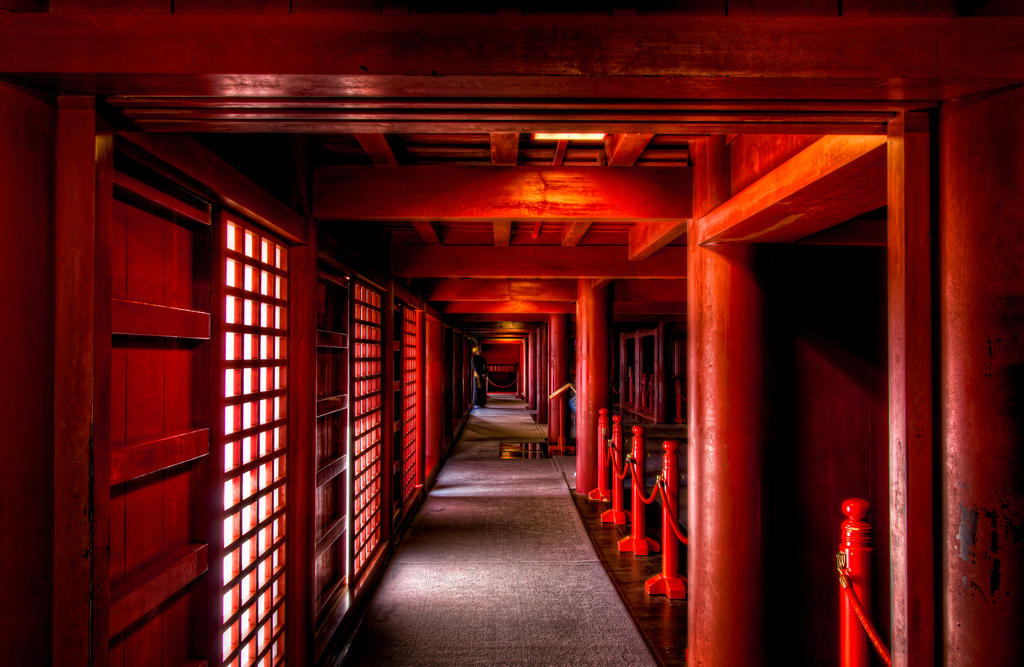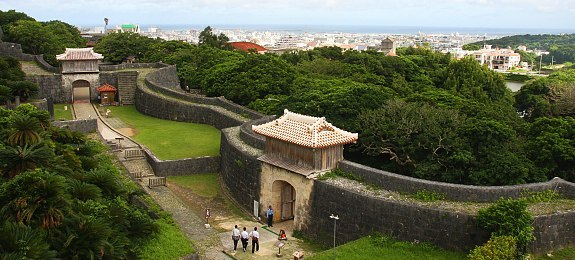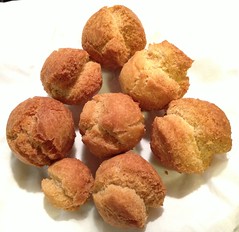Thursday, April 30th--The monorail is the only train that runs throughout ALL of Okinawa--and it only goes through half of the city of Naha. It runs straight from the Naha Airport to Shuri Castle. If you want to go anywhere else, you have to find other forms of public transportation. Having just one little monorail to use to get around instead of the extensive metro system in Tokyo seemed a little strange to us. Another difference between the Tokyo metro and the Naha monorail was that the monorail is completely above ground and gave us a good view of the city.
We went to the end of the monorail line and began our walk of a few blocks to Shuri Castle. On the way, we noticed this lion dog or "shisa" outside of a small restaurant. We took a picture with him, thinking he was cute and unique, but soon noticed that they are ALL OVER Okinawa. They grace many rooftops and are at almost every entrance we saw throughout the entire island.
The Okinawa shisa come primarily from the Chinese, but have changed through the centuries from the fearsome and regal guardians of royal palaces to more frolicsome and fun figures. Though this one is alone, shisa usually come in pairs. One will have a closed mouth to keep in the good spirits and the other has an open mouth to chase away the bad. It is thought that one shisa is a male and the other one a female. And although such guardian lion-dogs are found throughout Asia, it is believed that only on Okinawa are they placed on homes and commercial buildings. Elsewhere, they serve as symbols of authority at royal palaces and shrines.
We found the walls to Shuri Castle (on the east side) and walked around to the south looking for an opening. We found a picture of one of the gates a couple hundred years ago......
....right next to the actual gate! Here are some of the kids in front of the gate. Unfortunately, this gate was locked and no one was around. Shuri Castle is a very big deal....we couldn't figure out why no one was around. We were probably at the back entrance. This tends to be what we always do--we ALWAYS seem to find the back entrances and enter them first. We decided to backtrack and walk around to the north.
As we were walking, we found a whole bunch of Easter lilies! They were just growing in random spots all over the place! Oh. So. Pretty. We learned that the Easter lily is native to the Ryukyu Islands (the largest of these islands is Okinawa). We didn't know that these pretty lilies had ties to Japan! During our time in Okinawa, we saw Easter lilies all over the entire island. They grow here like dandelions do in America. We loved it!
The pathway along the rock wall of Shuri Castle.
Surely, we will find another gate that will let us in......
Things began looking up when we came upon this old shrine. The gate was locked, but we could look down on it from the hill above and enjoy its beauty. We found out later that this was the temple of the Ryukyu Kingdom's Royal Family.
By now, we were SWEATING. It was soooo hot and soooo humid, and we just aren't used to this kind of heat!
On the path, we next came upon this shrine set in the middle of a small pond. We crossed the bridge and explored it. The shrine was made of wood and looked like it was very old. It was no longer in use, but was fun to look at. It was built to store some precious Buddhist scriptures that had been received from the king of Korea.
Next to the shrine, there was these two old and small stone structures. A small pagoda and a block with a lily on it.
Ducks were swimming in the pond, and we found some baby ducks! So cute! We watched these ducks swim with their mama in the pond before moving on.
We next happened upon a really neat place! We found the entrance to the Japanese 32nd Army Underground Headquarters!! HOLY COW!! They built these headquarters under Shuri Castle thinking that because Shuri is such a cherished historical place, it would be spared any bombing by the Americans and therefore would be a safe place for the Japanese to have their army headquarters. The series of tunnels that created the entire army headquarters was huge!
In December of 1944, construction of the headquarters shelter began, which mobilized numerous Okinawan students and local residents. It was finished by March 1945 and the 32nd Army moved into the underground shelter and prepared for the battle against the U.S.
The shelter had five connecting tunnels, but these tunnels are now blocked and no one can go into the shelter.
Over 1,000 officers, soldiers, and the local civilians and students who served them lived together in the headquarters. The shelter was equipped with facilities and the equipment necessary for the battle command and along both sides of the passageways were double and/or triple bunk beds for the soldiers to rest.
On May 22, 1945, the Japanese military command decided to withdraw to Mabuni in the southern region on Okinawa. This was a hold-out strategy to delay a decisive battle on mainland Japan. A full-scale withdrawal began in the evening of May 27th, and the main areas and passageways of the headquarters were destroyed. Many precious lives were lost during the evacuation activities of both troops and civilians as the 32nd Japanese Army withdrew from these headquarters. On May 31, Shuri was seized by the U.S. forces.
Here are some pictures of what the inside looked like.
The entrance was barred, and the only thing around to commemorate what a significant place this is was the marker with a plaque of information and the few black and white pictures. There were also a couple of bouquets of flowers on the ground.
We moved on, still looking for main entrance to Shuri Castle.
The kids were amazed by the lush, thick foliage and by how big the leaves were.
Getting closer! This is just outside the entrance to the castle. It is known as the "Stone Gate of the Sonohiyan Utaki Shrine". This stone gate was the place where the king of the Ryukyus prayed whenever he left the castle to ensure a safe journey. The design consists of unique Okinawan techniques along with Japanese and Chinese influences. This stone gate was a Japanese National Treasure before WWII, but it was badly damaged during the Battle of Okinawa in 1945. It was restored in 1957. Logan is standing in front of it, and Audra and Nathan are wandering around in the corner of the picture.

We finally found the main entrance to Shuri Castle! This gate is called the Kankaimon which translates into "Gate of Welcome". It was originally built sometime around 1477-1500. Notice the shisa dogs on each side. From 1429 to 1879, Shuri Castle served the people of the Ryukyu Kingdom. For 500 years, the castle was the center of the Ryukyu politics, diplomacy and culture and was where the king lived. The castle walls are made from interlocking blocks of coral limestone, and measures to a length of 1,080 meters. The walls vary in height, from 6-15 meters high and 3 meters wide.
American Commodore Matthew Perry came to Shuri Castle twice, and demanded to see the king. It is recorded that both times he was denied an audience with the king or queen.

In July 2000, the G-8 Summit was held in Okinawa. During the summit, the world leaders from America, Russia, Germany, France, Britain, Canada, Italy, and Japan met for a banquet at Shuri Castle. Along with lobster and a seaweed appetizer, the menu for the banquet held at the ancient Shuri Castle featured Okinawan delicacies such as pigeon meat wrapped in soybean milk skin, pig ear and herb salad served with either black sugar cane molasses or seaweed sauce dressing. Our president at the time was Bill Clinton, and we saw pictures of him hobnobbing with the other world leaders of the time at the very places that we were standing as we toured this Okinawan historical treasure. (Notice the picture of the world leaders standing in front of Shuri Castle in the lower left corner.....we stood as a family in roughly the same spot.)
Audra liked the shisa dogs, she thought they were cute and wanted her picture taken with one.
We went through the gate and found a large grassy courtyard with several small buildings scattered around. We went through the courtyard and approached this large red gate so that we could get into the castle plaza. You have to pay to get into the castle plaza and Shuri Castle itself, and it was a little pricey for our large family.
Once we passed through the red gate, we entered a large plaza....and in front of us was THE Shuri Castle! It was absolutely stunning to behold! Absolutely beautiful!! (Remember the picture of the world leaders at the G-8 Summit? Here we are close to the same spot.)
The ancient Ryukyu Kingdom did a lot of trade with China, Japan and other countries in Southeast Asia, so there were many cultural influences throughout the Ryukyu culture from all of these other countries. We could quickly see that Shuri's architectural design and vermilion color differs significantly with the castles on mainland Japan. We loved the beautiful dragons on the roof. There are many dragons on the outside and inside of this castle because the dragon is a symbol of the throne.
The plaza itself was the site of many important rituals and ceremonies, including the New Year's ceremonies and the crowning of each king. The red and white tiles form ranks to mark where officials and aristocrats of various ranks would stand for these ceremonies. There is an aisle in the center--where we were standing--which was only used by the Ryukyu king, representatives of the Chinese Emperor, or others of similar rank. Overall, the plaza and the buildings surrounding it were built as a miniature of the Forbidden City (the Imperial Palace) in Beijing.
This castle stopped being the Ryukyu kingdom's capital when the Japanese showed up in 1879 and demanded that Okinawa become a part of Japan.
Most of the castle structures and and walls were reduced to ashes during the Battle of Okinawa in 1945. During the bombing of Shuri Castle, much of the valuable cultural heritage that spoke of the history of the Ryukyu Kingdoms were destroyed. Restoration began in 1972.
The intricate details make this building truly a work of art. Though this building is not original, it was rebuilt to be exactly in the same spot and same design as the original. Notice the two stone dragons on either side of the stairs. One dragon's mouth was open, the other mouth was closed. Pieces of the original pillars are in the Okinawa Prefectural Museum. While most of the castle's design reflects Chinese, Korean, and Japanese influence, these dragon pillars resemble those seen in palaces and temples in Cambodia and Thailand. The Ryukyu traded heavily with that region during the 14th-16th centuries.
On the south side of the plaza is the Nanden, or "South Hall". These buildings were very Japanese in style. They were used to house Satsuma officials and Japanese-style ceremonies.
It is believed that these buildings were originally built around 1620, though some excavations indicate that it could have been before that. In accordance with traditional Japanese architectural customs, these were never painted but instead the wood remained bare.
Sliding doors that can separate one large room into smaller rooms, lots of woodwork, and tatami mats...this is what we are used to seeing.
There are a few rooms in the back that the Ryukyu king would use as a place to take a break from his duties. The straight lines and simplicity of the Japanese style along with the gorgeous Japanese-style gardens outside made this place very peaceful and serene.

We then went on a tour of the inside of Shuri Castle itself. The entire inside was vermilion in color. It is three stories tall.

The castle had stunning decor. After walking around the understated and serene buildings of the Japanese Nanden, Shuri Castle commanded your attention with the bright colors and liberal use of gold. There were dragons everywhere.
Here are the kids in front of the throne room. Kirstina is thrilled to be here, as you can see. Audra wanted to wander around freely, but there were ropes marking off certain areas, and she wasn't happy that we were keeping her from going behind the ropes. All of the kids are carrying grocery bags containing their shoes. Just like everywhere else we have visited in Japan, we were required to take off our shoes. We carried them with us the whole time we were touring inside the buildings of Shuri Castle.
Here is a good look at the throne without seven children in the way.
This is what the crown of the Ryukyu king looked like.
There were a few other relics behind glass, including these decorated vials.
Talk about STEEP stairs!!
The pictures on the walls were painted scrolls, which is Japanese.
As we walked along, we noticed this glass on the floor that allowed us to look down at the stone wall below. Since the beginning of Shuri Castle, the castle building has been destroyed four times because of fires and the Battle of Okinawa. The stone pile that we can see through this glass are the remnants of a repeatedly destroyed and re-constructed Shuri Castle State Hall wall.
We left the castle and went into the Hokuden, or "North Hall". This was built in the style of the Chinese and was where visiting Chinese officials stayed and Chinese-style ceremonies were held. Commodore Perry was also entertained at a banquet in this building. We went inside and found a few small exhibits that helped to learn more about Shuri Castle. One exhibit was this model of the castle, the North and South Hall, and the striped plaza. This model shows what the plaza would have looked like during a New Year's Day ceremony in which officials and aristocrats would fill the plaza.
This is a ceremonial umbrella that was used to shade the king and nobles during parades. Fancy!
We were amused to see shisa dogs at the sink in the bathrooms. There is a shisa dog on the tile above the sink, and a shisa head for the water spout. A dragon was painted on the sink itself.
Besides the plaza and its surrounding buildings, there is a lot to see around Shuri Castle. We wandered around some more, and even though we knew where we were, the whole place is so vast that we still felt a little lost.

Some of the Shuri Castle wall, the city of Naha, and the East China Sea in the background.
The kids were given these pamphlets containing a map of Shuri Castle and some information regarding the historical places to see while on the grounds. There were specific places that it taught the kids about, and when you went to that spot there would be a table with a stamp. The kids could stamp their pamphlet in the box provided next to the information and then move onto the next place. It was kind of like a treasure hunt for them and they ran all over Shuri Castle bound and determined to get all of the stamps.
This gate was one of the places. It was not totally destroyed by the Americans during the Battle of Okinawa.
Another place where the kids got a stamp was this dragon-shaped water spout. This spout was saved from the rubble after the 1945 bombing. It is believed to be thousands of years old.

This sundial was yet another stop on the scurry to get all the stamps. This sundial was used to tell time at the castle from 1739-1879.
The sundial is on the left in this picture, and as the kids were getting their stamp, I noticed the beginnings of sunset over the ocean.
The last stop for stamps was an outlook over the city of Naha. It was a perfect time to come here, right at sunset! We enjoyed the view for a bit.
With all of the kids' pamphlets full of stamps, it was time to leave.
On our way out, we meet this security guard. The people who work at Shuri Castle wear traditional Okinawan clothing. He was kind enough to take a picture with the kids.
The entire castle is lit up at night, and it is an impressive sight. By now, our feet were killing us! We were still sad to leave, though. Loved this place!! There is so much Okinawan history here, and the whole grounds is so vast that it's hard to take it all in.
The kids posed for the camera doing the infamous Karate Kid move. Karate has its beginnings in Okinawa.

This is a very old picture of the original Shuri Castle with some men in the plaza refining their karate skills. Christopher and Logan have been taking a few karate lessons in Tokyo. Their sensei has taught them about the history of karate during these lessons. They learned that sometime before the 19th century, Okinawan peasants were attacked by various warlords. The peasants lived a simple life and didn't have weapons of any kind. They developed karate as a means to defend themselves with their bare hands against the armor-wearing and sword-wielding samurai attackers.
Our afternoon spent at Shuri Castle was simply amazing! We learned a lot about Okinawan history and enjoyed every bit of it!
























































